The halving reduces the rate at which new coins enter circulation, aiming to prevent inflation and increase scarcity, similar to the mining of precious resources.
In the dynamic world of cryptocurrencies, "halving" is a common but unique process for each currency. In addition to Bitcoin, cryptocurrencies like Litecoin (LTC), Bitcoin Cash (BCH), Bitcoin SV (BSV), Dash (DASH), and Zcash (ZEC) will also undergo halving. This article delves into the details of these cryptocurrencies' halving events.
About Cryptocurrency Halving
Cryptocurrency halving is a significant event in the lifecycle of certain cryptocurrencies, especially Bitcoin and its derivatives. It refers to the process of halving the rewards miners receive for adding new blocks to the blockchain. This typically occurs at predetermined intervals, after a certain number of blocks have been mined. Halving reduces the rate at which new coins enter circulation, aiming to prevent inflation and increase scarcity, similar to the mining of precious resources. It has a significant impact on the economics of cryptocurrencies, including price, mining profitability, and network security.
Cryptocurrency Halving Date List
The table below summarizes the currencies and related parameters that underwent halving as of December 12, 2023.
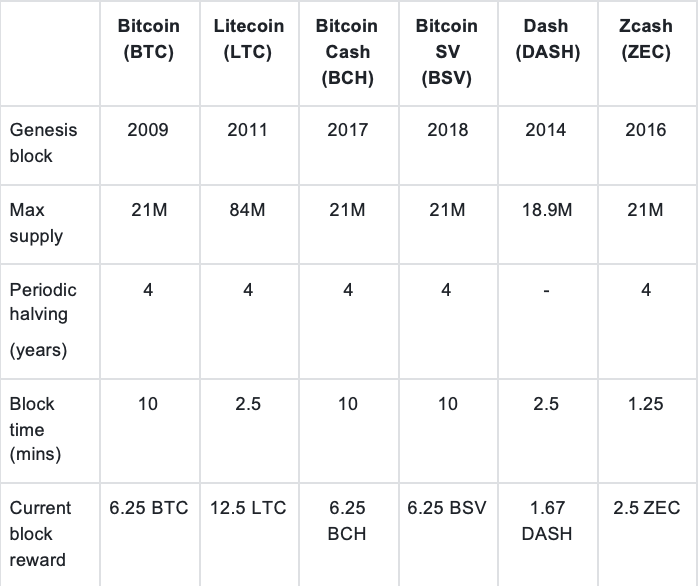
Bitcoin Halving
Bitcoin (BTC) is the first and most well-known cryptocurrency, invented by an unknown person or group using the pseudonym Satoshi Nakamoto in 2009. It operates on a decentralized computer network using blockchain technology, allowing secure peer-to-peer transactions without the need for intermediaries.
Bitcoin quickly gained popularity among early adopters and tech enthusiasts, with its value skyrocketing from a few cents to over $1000 in just a few years. In the following years, other cryptocurrencies, such as Litecoin, Polkadot, and Cardano, also known as "altcoins," were created, each with its unique features and use cases.
The next Bitcoin halving is expected to occur at block height 840,000, estimated to take place between April 25 and May 8, 2024. The following is the schedule for the Bitcoin halving event:
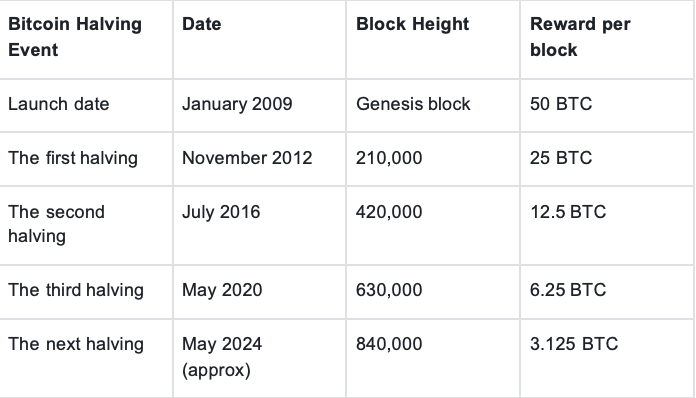
Litecoin Halving
Litecoin, created by former Google engineer and Coinbase engineering director Charlie Lee in October 2011, is often referred to as the "silver" to Bitcoin's "gold." It operates on a decentralized, open-source global payment network. Litecoin's founder, Charlie Lee, intended for Litecoin to overcome certain limitations of Bitcoin, making its transaction confirmation times faster and more suitable for daily transactions.
Similar to Bitcoin, Litecoin's halving is a scheduled event, occurring approximately every four years or after mining 840,000 blocks. This cycle is expected to continue until 2142. Although its impact on the market may not be as pronounced as Bitcoin's, LTC typically experiences increased trading volume and price fluctuations before the halving event.
Litecoin halving date:
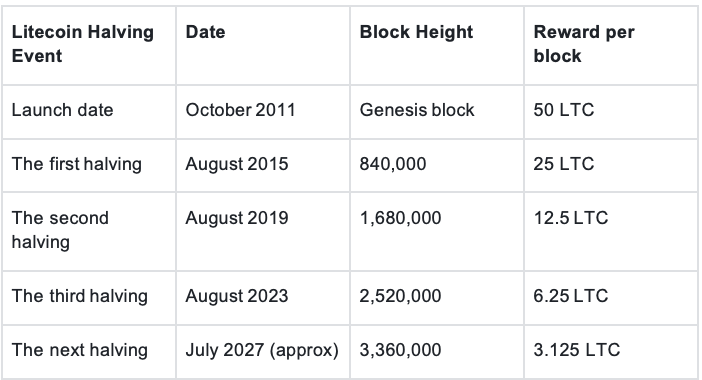
Bitcoin Cash Halving
Bitcoin Cash (BCH) emerged from a hard fork of the Bitcoin blockchain in August 2017. With its larger block size, BCH can process over 100 transactions per second, providing a decentralized currency system that emphasizes peer-to-peer electronic cash.
The first halving of Bitcoin Cash occurred in April 2020. Contrary to expectations, BCH's halving did not occur simultaneously with Bitcoin's due to different mining algorithms, resulting in an accelerated block mining rate and an earlier halving date.
Bitcoin Cash halving date:
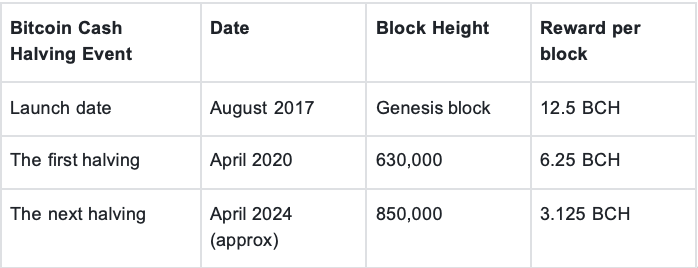
However, after the halving event, there was an almost two-hour stagnation before the next block was mined. Despite BCH's processing capacity of approximately 116 transactions per second, this rate plummeted to only 1.11 TPS.
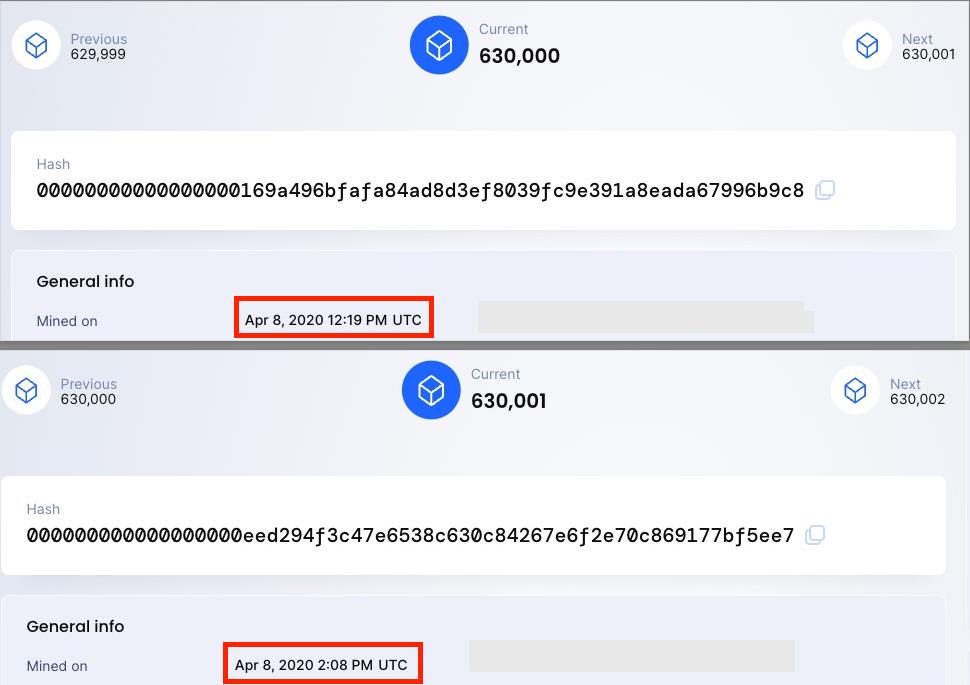
Following the halving, block 630,001 was mined two hours later (source: blockchair.com).
As BCH shares the same mining mechanism as Bitcoin, miners can easily switch between the two. This led to a significant number of miners leaving the Bitcoin Cash network in search of better profits elsewhere. As a result, the mining difficulty level increased, making it less profitable for miners to continue mining BCH tokens. Therefore, the upcoming BCH halving event may be controversial.
Bitcoin SV Halving
Bitcoin SV (BSV), derived from a fork of BCH, was created by a team led by Craig Wright, who claims to be Satoshi Nakamoto, in November 2018. BSV's unrestricted block size, up to 4GB, enables low-cost and stable transaction fees.
The unrestricted block size of BSV allows miners to choose their preferred block size. However, this flexibility brings the risk of centralization and vulnerability to attacks, as demonstrated by an event in October 2022 when an unknown miner controlled over 51% of the hash power.
Bitcoin SV halving date:
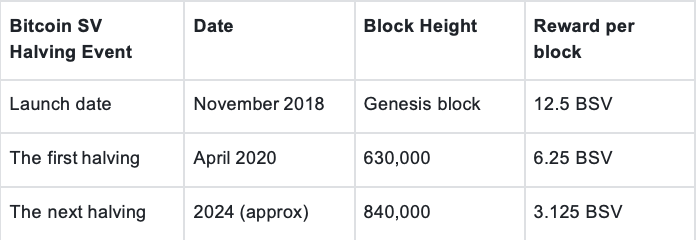
Dash Halving
Dash, an open-source cryptocurrency created in 2014, branched out from the Bitcoin protocol. It operates as a decentralized autonomous organization (DAO) and is managed by "masternodes," powerful servers supported by assets staked in Dash, aimed at providing advanced services and governance on the blockchain.
Unlike the sudden halving of other cryptocurrencies, Dash experiences a gradual halving process, reducing by approximately 7.14% every 383.25 days.
Dash halving date:
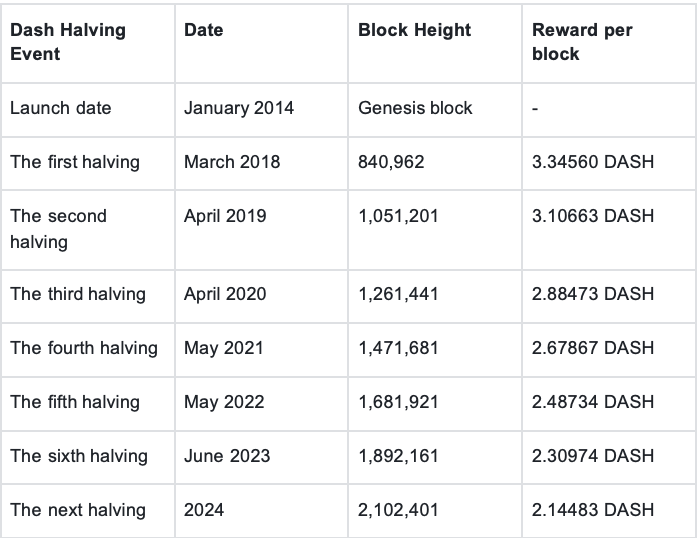
Zcash Halving
Zcash, developed by experts from MIT and Johns Hopkins University, is known for its privacy technology, providing confidential transactions.
Zcash has a unique reward distribution method. At launch, Zcash established a reward allocation plan called the Founders' Reward (FR) to fund the development of Zcash. According to the reward plan, 80% (5 ZEC) of the mining reward goes to miners, while 20% is allocated to the founders and investors of the Electric Coin Company.
After the expiration of the FR, the community voted and approved that miners would receive 80% of the mining reward. The remaining 20% would be distributed among funding projects for independent third-party developers (8%), the Electric Coin Co (7%), and the Zcash Foundation (5%), supporting miners to continue mining ZEC.
Zcash halving date:
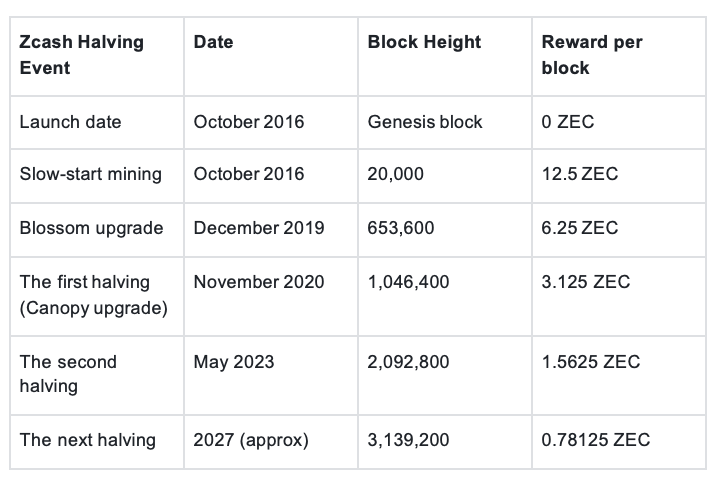
Despite their different halving mechanisms, these cryptocurrencies share a common goal: regulating the influx of new tokens, balancing supply and demand, and maintaining the value of tokens. As the cryptocurrency field evolves, these halving events play a crucial role in shaping the future of each currency. Please continue to follow Bitget Academy for the latest developments in this fascinating field.
Disclaimer: The views expressed in this article are for reference only. This article does not constitute an endorsement of any discussed products and services, nor does it constitute investment, financial, or trading advice. Before making financial decisions, consult qualified professionals.
免责声明:本文章仅代表作者个人观点,不代表本平台的立场和观点。本文章仅供信息分享,不构成对任何人的任何投资建议。用户与作者之间的任何争议,与本平台无关。如网页中刊载的文章或图片涉及侵权,请提供相关的权利证明和身份证明发送邮件到support@aicoin.com,本平台相关工作人员将会进行核查。




